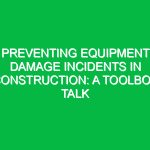Introduction
In today’s fast-paced work Environment, the concept of ergonomic Safety has gained paramount importance within the Health, Safety, and Environment (HSE) domain. Ergonomic Safety refers to the science of designing the workplace, keeping in mind the capabilities and limitations of the worker. Its primary objective is to enhance comfort, efficiency, and productivity while minimizing the risk of injury. As the workforce continues to evolve, understanding and implementing ergonomic principles becomes critical for both employers and employees. This article will delve into the essential aspects of ergonomic safety, its relevance to HSE, actionable insights, and the Regulations that govern it.
The Importance of Ergonomic Safety in the Workplace
Ergonomic safety is not just about comfort; it plays a crucial role in promoting overall health and well-being in the workplace. Poor ergonomic practices can lead to a range of musculoskeletal disorders (MSDs), which are among the leading causes of workplace injuries. According to the U.S. Bureau of Labor Statistics, MSDs accounted for over 30% of all workplace injuries in recent years. By adopting ergonomic principles, organizations can significantly reduce the incidence of these injuries, resulting in lower healthcare costs, improved employee morale, and increased productivity.
Key Concepts of Ergonomic Safety
Understanding Ergonomics
At its core, ergonomics is about fitting the job to the worker, rather than forcing the worker to adapt to the job. This involves understanding the physical and cognitive capabilities of employees and designing tasks, workspaces, tools, and equipment accordingly. Ergonomics encompasses various fields, including biomechanics, industrial design, and psychology, making it a multidisciplinary approach to enhancing Workplace Safety.
Common Ergonomic Risks
Identifying ergonomic risks is a fundamental step in creating a safe workplace. Common risks include:
- Repetitive Strain Injuries (RSIs): These occur from repetitive motions over time, such as typing or assembly line work.
- Poor Posture: Sitting or standing incorrectly can lead to back pain and other musculoskeletal issues.
- Prolonged Static Positions: Remaining in one position for extended periods can cause discomfort and fatigue.
- Lifting and Carrying Heavy Loads: Improper lifting techniques can result in serious injuries.
Best Practices for Ergonomic Safety
Workstation Design
A well-designed workstation is the cornerstone of ergonomic safety. Here are some key elements to consider:
- Chair Height: Ensure that the chair is adjustable so that feet can rest flat on the floor, and knees remain at a 90-degree angle.
- Desk Height: The desk should allow for elbows to be at a 90-degree angle while typing, reducing strain on wrists.
- Monitor Position: The top of the monitor should be at or slightly below eye level, about an arm’s length away, to avoid neck strain.
Regular Breaks and Movement
Encouraging employees to take regular breaks is essential for maintaining ergonomic safety. Short breaks every hour can help reduce fatigue and improve focus. Incorporating stretching exercises or brief walks can also alleviate tension built up from prolonged sitting.
Training and Awareness
Education is a vital component of ergonomic safety. Employers should provide Training sessions that cover:
- Correct lifting techniques.
- Proper posture and workstation setup.
- Identification of ergonomic Hazards in the workplace.
Utilizing Ergonomic Tools
Investing in ergonomic tools can enhance safety and comfort. Examples include:
- Ergonomic Keyboards and Mice: These devices are designed to reduce strain on the hands and wrists.
- Standing Desks: Adjustable desks allow employees to alternate between sitting and standing, promoting better posture.
- Footrests: These can help maintain proper alignment and reduce pressure on the legs and feet.
Real-Life Examples and Case Studies
To illustrate the importance of ergonomic safety, consider the case of a manufacturing company that implemented ergonomic assessments. They found that workers frequently complained of back pain due to improper lifting techniques. By providing training on safe lifting practices and investing in mechanical lifting aids, the company saw a 25% reduction in reported injuries within six months. This not only improved employee satisfaction but also reduced workers’ compensation costs.
Another example comes from a tech firm that faced high turnover rates attributed to repetitive strain injuries among its employees. After conducting a thorough ergonomic evaluation of their workstations, they redesigned their office layout, introduced adjustable furniture, and provided employees with ergonomic equipment. As a result, employee retention improved, and productivity increased significantly.
Regulations and Standards Governing Ergonomic Safety
Occupational Safety and Health Administration (OSHA)
In the United States, osha provides guidelines and regulations regarding Workplace Safety, including ergonomic safety. While OSHA does not have a specific standard for ergonomics, it emphasizes that employers must provide a safe work environment free from recognized Hazards. This implies that companies should proactively address ergonomic risks to comply with safety regulations.
International Ergonomics Association (IEA)
The IEA promotes the application of ergonomics principles across various sectors, encouraging organizations to adopt Best Practices that enhance worker safety and productivity. Their guidelines serve as a valuable resource for businesses striving to implement effective ergonomic measures.
The Benefits of Prioritizing Ergonomic Safety
Prioritizing ergonomic safety yields numerous benefits, including:
- Reduced Injury Rates: Implementing ergonomic practices significantly lowers the risk of workplace injuries.
- Increased Productivity: Comfortable employees are more focused and productive, leading to better business outcomes.
- Enhanced Employee Satisfaction: A commitment to ergonomic safety fosters a positive work environment, boosting morale and retention.
- Lower Healthcare Costs: Fewer injuries translate to reduced healthcare expenses and workers’ compensation claims.
Conclusion
Unlocking ergonomic safety is essential for creating a healthier workplace that prioritizes employee well-being. By understanding the principles of ergonomic safety, recognizing potential risks, and implementing Best Practices, organizations can foster an environment that not only enhances productivity but also promotes health and safety in the workplace. As we move forward, it is crucial for both employers and employees to remain vigilant in addressing ergonomic concerns, ensuring compliance with regulations, and continually adapting to the evolving needs of the workforce. Through these efforts, we can create a sustainable and safe working environment that benefits everyone.


